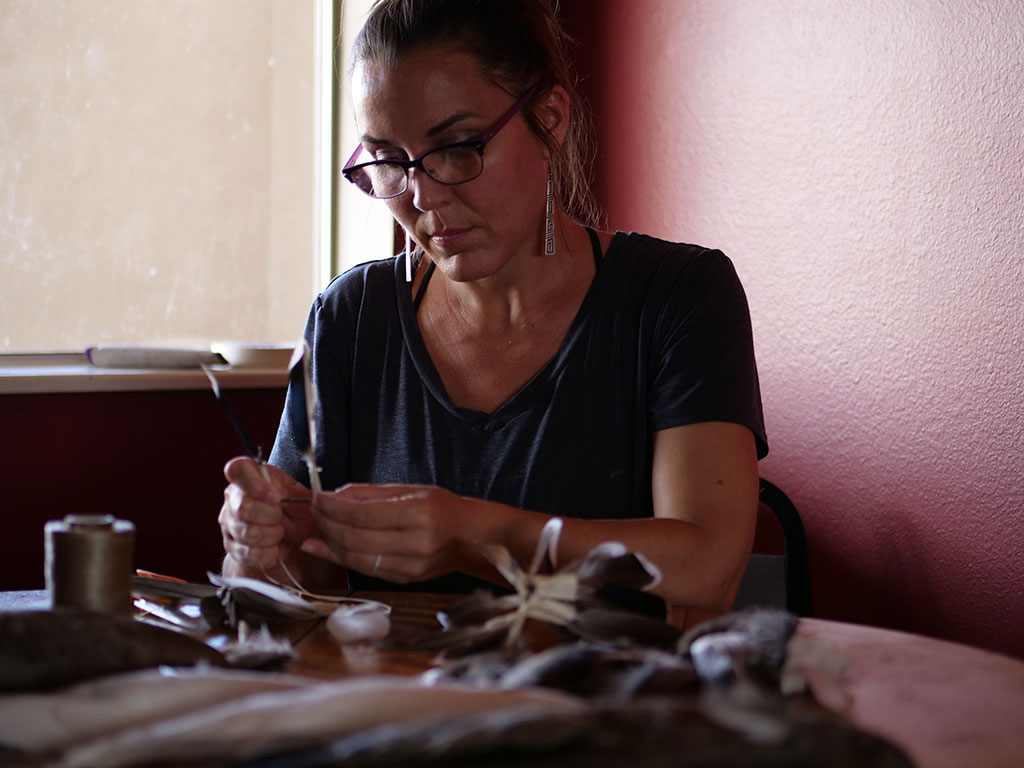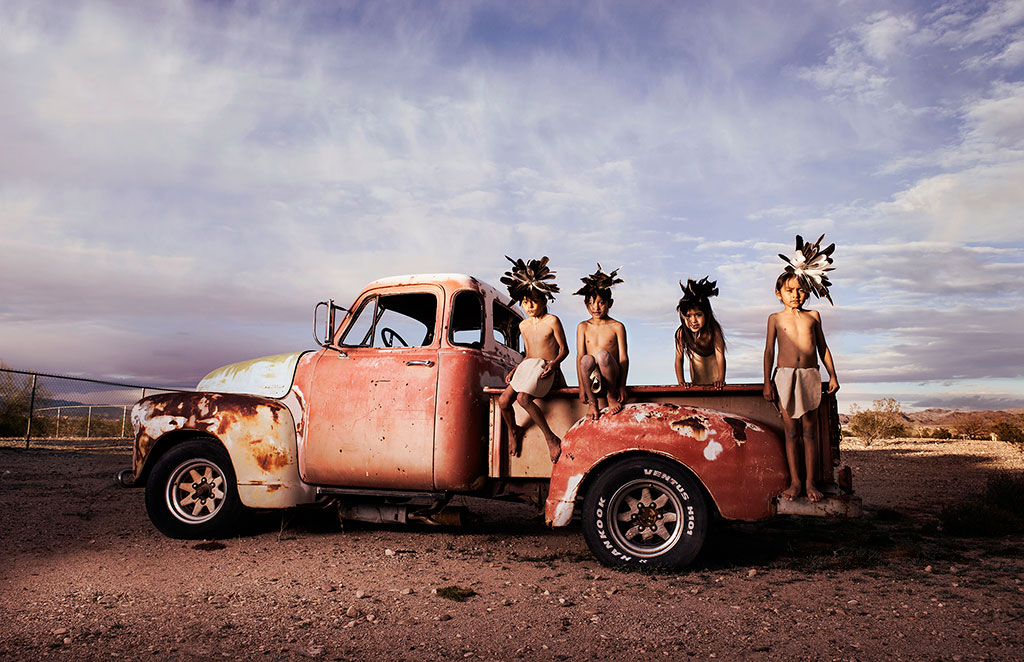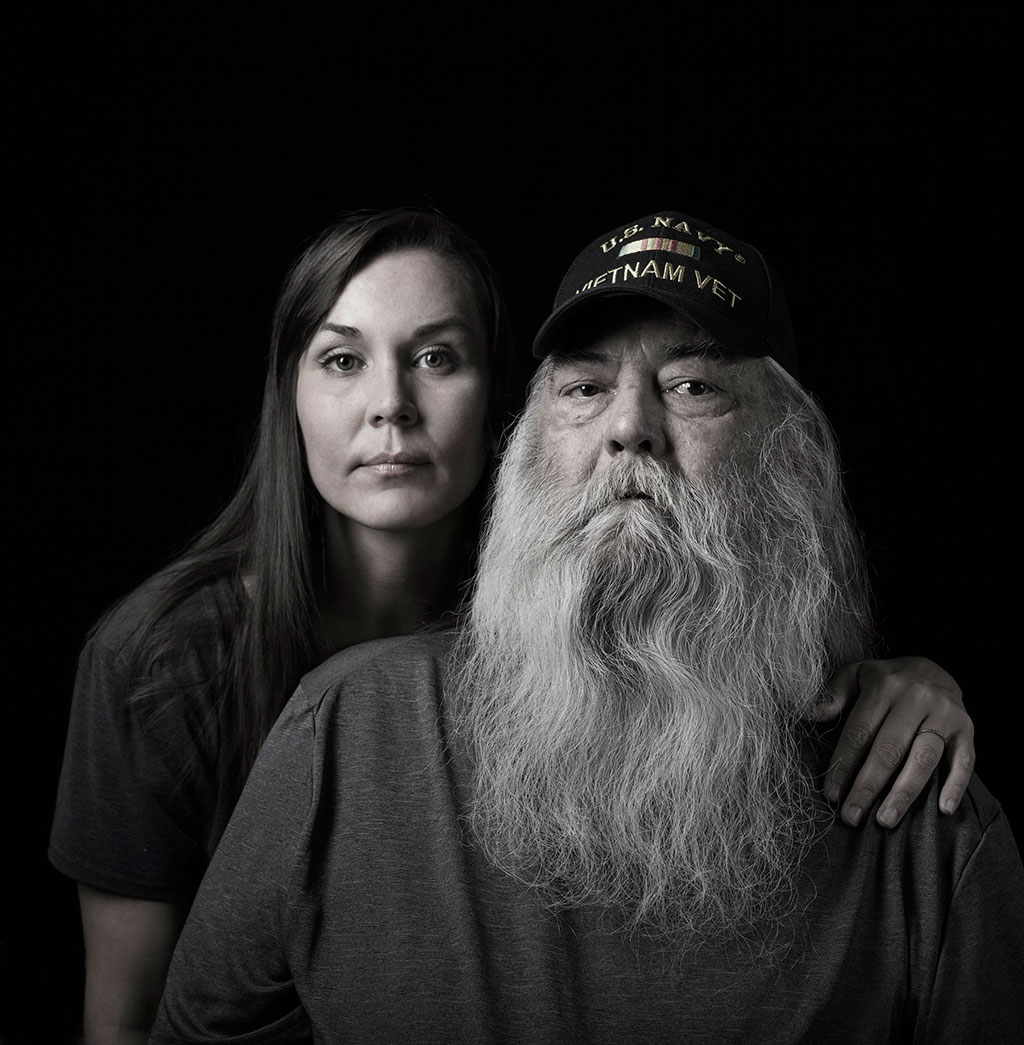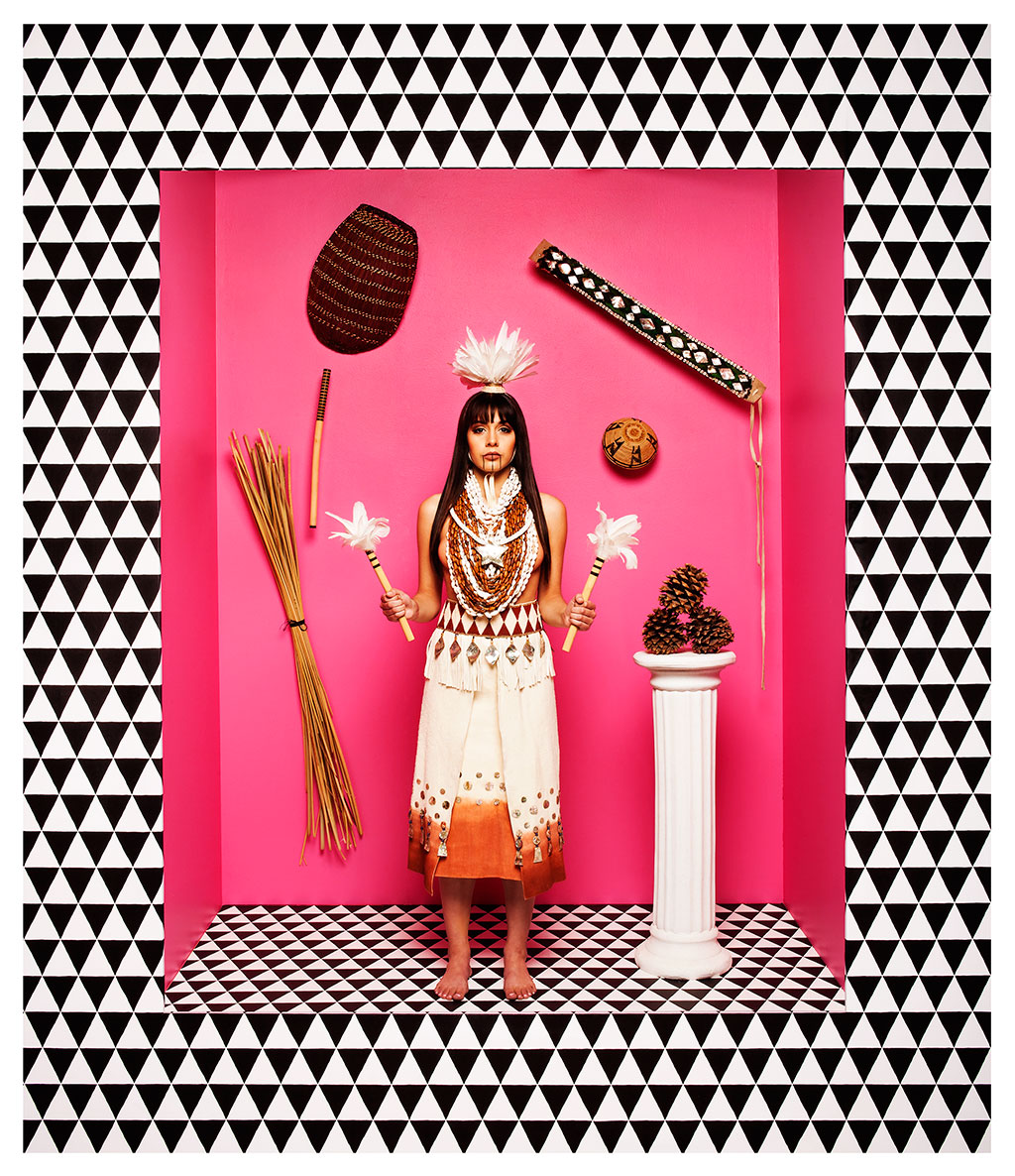loading...
Look and See: Who is in the Photograph?
In this lesson, students will watch the segment from Craft in America’s IDENTITY episode featuring photographer Cara Romero. Romero states that when she went to college at the University of Houston she discovered, “I was the only Native American and everyone around me was completely unaware that we existed… And I knew almost instantly that I wanted to be able to communicate visually, through photography, modern native life.” Students will look closely at Romero’s Naomi from the First American Dolls series; the Jackrabbit, Cottontail and Spirits of the Desert series; and the portrait of Cara Romero with her father. Students will look for the stories about the people in the images and draw the people in their sketchbooks. Finally, students will plan and practice telling a story about someone special using photography.
DOWNLOAD
Look & See: Who is in the Photograph?
Full Guide & Worksheets
Background Reading
Lesson Overview
Teaching Tips
Teaching Tips for Teachers
Further Information
Resources & Materials for Teaching
Vocabulary
Vocabulary & Key Terms
Discussion Questions
Discussion Questions for Students
Worksheet #1 for Students
Look & See: Who is in the Photograph?
Worksheet #2 for Students
Who will you be in your Photograph?
“With a photograph you get one frame to tell a story so how can you create a story that communicates as much as you possibly can in one moment.”
– Cara Romero
LESSON OVERVIEW
Grade Level: K–4
Estimated Time: two 45 minute class periods
Craft in America episode: IDENTITY
Background Information

Cara Romero, a contemporary photographer and member of the Chemehuevi Indian Tribe of the Chemehuevi Reservation (a branch of the Southern Paiute) of the Mojave Desert, CA, is a passionate spokesperson for indigenous cultural and environmental issues. Her complex and nuanced images combine traditional iconography with a contemporary perspective, bringing past, present and future into consideration. The artist orchestrates a balancing act in her photography by rewriting stories of Indian identity, battling cultural misappropriation, and confronting stereotypes, particularly of Native women, all the while preserving tradition and maintaining cultural sensitivity.
Key Concepts
- We take photographs of people for many different reasons.
- We can tell a story about someone by taking a photograph.
- You can become a character in a photograph.
Critical Questions
- Why do we take photographs of people?
- How can we tell a story about someone by taking a photograph?
- How can you become a character in a photograph?
Objectives
Students will:
- Describe reasons we take photographs of people.
- Become a character in a photograph.
- Tell a story in the photograph about the character represented.
Vocabulary
Chemehuevi, Chumash, identity, ancestor, character, regalia, indigenous
Interdisciplinary Connection
Social Studies: This lesson explores aspects of Native American cultures through examining Cara Romero’s photographs. In the episode, Romero talks about her father wearing his Vietnam Veterans cap in his photographed portrait, and how it is important to him to represent himself that way. The Smithsonian National Museum of the American Indian is raising funds to build a National Native American Veterans Memorial on museum grounds at the National Mall in Washington, D.C. Students can learn more about Native Americans’ extensive contributions to U.S. military service since Colonial times. The website includes stories of Native American veterans and their military service. americanindian.si.edu/nnavm
National Standards for Visual Arts Education
This lesson addresses the following standards. The performance standards listed here are directly related to the lesson’s goals.
- Anchor Standard #1, CREATING: Generate and conceptualize artistic ideas and work.
- Anchor Standard #2, CREATING: Organize and develop artistic ideas and work.
- Anchor Standard #4, PRESENTING: Select, analyze, and interpret artistic work for presentation.
- Anchor Standard #8, RESPONDING: Interpret intent and meaning in artistic work.
- Anchor Standard #11, CONNECTING: Relate artistic ideas and works with societal, cultural and historical context to deepen understanding.
Resources
- Craft in America’s IDENTITY episode is viewable online at www.craftinamerica.org/episodes/identity
- The National Museum of the American Indian website: Cara Romero’s work brings together the past and the present of Indian life. The National Museum of the American Indian provides abundant content, historic and contemporary, for potential exploration by your students. For example, they may decide to tell a story about an Indian artist of yesterday or today. Many contemporary Native American artists are featured on the site. americanindian.si.edu
Worksheets
Materials
- Sketchbooks
- Pencils and colored pencils
- Copies of images of Naomi from the First American Dolls series, the Jackrabbit, Cottontail and Spirits of the Desert series, and Cara Romero’s self portrait with her father for students to examine closely
- Materials for story and scene creation: Two possible ways of working include students dressing as a character, setting a scene to pose in, and taking each other’s pictures. Another way is to take the students’ photos, print them out, and allow them to place their cutouts in a miniature setting or scene. For both, the following materials are useful: dress-up clothes, masks, lengths of fabric, bulletin board paper for costumes and capes are examples of costumes. To make miniature scenes or settings, collected random objects, toys, and all sorts of art materials will help with creation. Drawing paper and media, paints and brushes, small boxes, glue, scissors, and magazines for cutout images will provide for detailed scenery settings.
- Digital cameras and color printer
- Construction paper, poster board, or mat board for mounting students’ photographs
INSTRUCTIONAL STRATEGIES
Students will watch the segment on photographer Cara Romero in the IDENTITY episode. Students examine Romero’s Naomi from the First American Dolls series, the Jackrabbit, Cottontail and Spirits of the Desert series, and the photo session of Cara Romero’s self portrait with her father, in which he wears his Vietnam veteran’s cap. Students will examine the photos closely to look for the stories the characters seem to be telling. Students sketch the images in their sketchbooks. Finally, students decide on a character they would like to represent, what scene they will create, and then capture their work with a photo.







(Video and discussion: one 45 minute class period)
Before Viewing
Preview the video (13:48-23:20). The sections are outlined here as you may want to start and stop the video to clarify points and answer students’ questions:
- The introduction; and Cara Romero photographs a mother and daughter (13:48-15:47)
- Cara Romero and curator Kristen Dorsey discuss the large photograph Naomi from the First American Dolls series (15:48-17:03)
- Cara Romero’s photography session with her four young nephews for the Jackrabbit, Cottontail and Spirits of the Desert series (17:04-17:55)
- Romero talks about using Photoshop to combine images (17:56-19:15) • The boys are shown in their everyday clothes, and then dressing in their traditional wear for another photo session (19:16-21:32)
- A portfolio of Romero’s photos is shown (21:33-21:53)
- She talks about her family (husband and ceramic artist Diego Romero is also featured in IDENTITY) (21:53-22:17)
- Cara Romero’s self portrait photography session with her father (22:18-23:21)
Introduce the scope of the lesson to students, sharing the key concepts, critical questions, and objectives. Share a bit about what they will see. Show the video, stopping and starting where needed so you may clarify students’ understanding, and answer any questions they may have. You may want to hand out the Look and See: Who is in the Photograph? worksheet so you can stop the video after each section.
After Viewing
Hand out the Look and See: Who is in the Photograph? worksheet. Have students take out their sketchbooks and pencils. Begin a discussion of the video. What did students find interesting? Go through the questions on Look and See: Who is in the Photograph? worksheet, letting students work with a partner to share their ideas and answers, and then share their answers as a group.
Discussion
1. It is titled Naomi. She is Northern Chumash and she wears traditional dance regalia.
2. One possible story is: “Naomi is a woman who got dressed in traditional clothes and a headdress of dove and goose feathers. Then she pretended to be like an American Girl Doll in a big doll box, with special accessories all around her. She has dance sticks in her hands.” Cara Romero says that the image “… is a way to create visibility for those things that are still here against all odds; to be a powerful story of resilience.” Remind students that many of the American Girl dolls represent girls who lived in the past. Help students understand that the Naomi “doll” represents a person living in the present and who has strong connections with the people and traditions from the past.
3. Encourage students to add the feathered headdress; later they can consider all the different headgear within the photographs.
4. The four young boys are Romero’s nephews, and they are cousins. Kiyanni introduces his cousins as he points to them: “His name is P.J. but we call him Curtiss; John; and Winka.”
5. When they come to Cara Romero’s studio, the boys are wearing caps and shorts and tee shirts; familiar contemporary clothes.
6. Kiyanni replies to a question about what the boys are wearing: “We’re wearing the Indian stuff.” He then replies to the question of why they are wearing the Indian stuff: “Because we are!” Ask students to share their ideas about why the boys are wearing the “Indian stuff.”
7. The boys represent characters in the series Jackrabbit, Cottontail, and Spirits of the Desert; Romero’s series based on traditional fables. She presents them as “…four little mythological characters [who] came back to visit Coachella Valley and responded to the landscape…time travelers from Chemehuevi.”
8. Encourage students to think about the different clothes and the boys’ connection to the old and the new. Help students understand the importance of props and costumes when telling a story.
9. He wears a U.S. Navy Vietnam veterans hat.
10. Cara Romero says, “It’s important for my dad to let people know he’s a Navy veteran. I know by him wearing his veterans hat it really frames what era he grew up in, and what made him the man he is today.”
11. Ask students to share their ideas about what the hat adds to the story.
After Discussion
Hand out the Who Will You Be in Your Photograph? worksheet. Help students to think about why we make photographs of people, about photographs as a storytelling device, and help them to think about who they would like to be in their photograph. How will they show a story about the character by what they add to the photograph? Several possible themes for telling a story that relates to Romero’s work include those below. However, practicing setting scenes and acting out roles may get students excited; as ideas multiply students may take many different paths. They might:
- Take a photo as the artist Cara Romero, or of themselves as artist/photographer
- Take a self portrait set in a scene that represents the place where they live or their connection to environment (whether natural or manmade)
- Represent oneself as someone they are fond of, or a character in a movie, book, or story, or as an ancestor.
Studio Production
Help students experiment with the materials available, and to try out different ideas. With a digital camera, they can take several pictures and look at them to change their idea and to eventually choose their favorite (like Cara Romero does.)
CLOSING STRATEGIES
Reflection
Print the photographs for students. Mount the photos on poster board or mat board, or help students to do so. As a class, allow students to present their work and share their stories. You might talk about: Is their work like Cara Romero’s in any way? (Perhaps it is alike in that it features a person and suggests a story.) How is their work different from the photographs they examined?
Assessment
In discussions with the class and with individual students throughout the lesson; by examining the students’ worksheets; and by witnessing the students’ studio work, it should be evident that the student:
- Can describe several reasons we take photographs of people.
- Decided on a character to represent and created a photograph in that character.
- Added details to tell a story about the character they represented in the photograph
Extensions
The National Museum of the American Indian features images and information from a past exhibit: Circle of Dance. Within this section is a menu tab that connects to images of varied traditional Indian dance regalia (as Romero describes when discussing the photo Naomi) and contemporary images of the dances performed today. An additional lesson could feature looking at these elaborate garments, and finding out about the materials used in their construction and the meaning behind the materials and designs. americanindian.si.edu/static/exhibitions/circleofdance/#introduction
Authors
The Education Guide for IDENTITY was developed under the direction of Dr. Marilyn Stewart, Professor Emerita of Art Education, Kutztown University of Pennsylvania, Kutztown, PA. Lead author for Look and See: Who is in the Photograph? is Dr. Amy Albert Bloom, December, 2019.